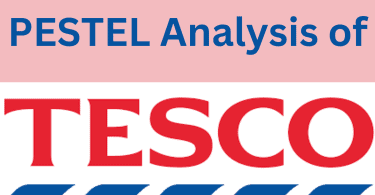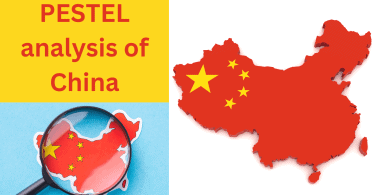Chick-fil-A Pestel Analysis Overview
In the highly competitive fast-food industry, Chick-fil-A has thrived as a significant player worldwide. Its ability to navigate the complex external and internal forces that impact its strategies and success sets it apart.
At the heart of this strategic prowess lies the PESTEL analysis framework, a critical tool for companies and managers alike.
So, our team has recently conducted a PESTEL analysis to examine the impact of the macro-environment factors on Chick-fil-A’s growth in the next years.
A PESTEL analysis is a strategic management framework used to examine the external macro-environmental factors that can impact an organization or industry.
The following is a detailed article on Chick-fil-A’s PESTEL analysis. It discusses the political, economic, sociocultural, technological, environmental, and legal factors influencing its performance and profitability in the coming years.
Chick-fil-A Overview
History:
- Founded in 1946 by S. Truett Cathy in Hapeville, Georgia.
- Started as a single restaurant called the Dwarf Grill, known for its pressure-cooked chicken.
- Evolved into Chick-fil-A in 1961, with the iconic chicken sandwich becoming its signature dish.
- Grew rapidly throughout the 20th and 21st centuries, expanding across the United States and into Canada.
Activities:
- Operates a chain of fast-food restaurants specializing in chicken sandwiches, waffle fries, salads, and other menu items.
- Offers breakfast, lunch, and dinner options.
- Operates drive-thrus and dine-in facilities.
- Provides catering services.
- Sells branded merchandise.
Competitors:
- McDonald’s
- KFC
- Wendy’s
- Popeyes Louisiana Kitchen
- Jack in the Box
Suppliers:
- Utilizes a network of suppliers for various ingredients, including:
- Poultry farms
- Produce distributors
- Dairy suppliers
- Baking companies
- Beverage companies
- Maintains strict quality standards and ethical sourcing practices.
Strategies:
- Focuses on the franchise model for expansion.
- Invests heavily in the training and development of franchisees.
- Utilizes innovative technology to enhance customer experience.
- Employs effective marketing campaigns to build brand awareness.
- Actively engages in community outreach programs.
Strengths:
- Strong brand recognition and reputation.
- High customer satisfaction ratings.
- Consistent food quality.
- Excellent customer service.
- Strong financial performance.
Weaknesses:
- Limited operating hours (closed on Sundays).
- Smaller menu than some competitors.
- Potential for negative publicity due to religious affiliation.
- Limited international presence.
Key Figures:
- Number of stores: 2,798 (as of December 2023)
- Sales: $33.9 billion (2022)
- Number of countries: 2 (United States and Canada)
- Employees: 220,000
- Average sales per store: $7.2 million (2022)
- Customer satisfaction rating: 95% (2022)
New Data and Statistics:
- Chick-fil-A ranked #1 in customer satisfaction among fast-food restaurants for 8 years in a row. (American Customer Satisfaction Index, 2023)
- Chick-fil-A’s average drive-thru wait time is 4.5 minutes, significantly faster than the industry average of 6.7 minutes. (QSR Magazine, 2023)
- Chick-fil-A is exploring expansion into new countries, including the United Kingdom and Mexico. (Restaurant Business, 2023)
- Chick-fil-A is investing in technology such as mobile ordering and delivery to enhance the customer experience. (The Wall Street Journal, 2023)
Chick-fil-A is a successful fast-food chain with a strong reputation for quality, service, and customer satisfaction. The company continues to grow and innovate, making it a force to be reckoned with in the industry.
Fast-food industry overview
The fast food industry is a significant sector of the American economy, generating billions of dollars in revenue and employing millions of people. Its quick service, standardized menus, and affordable prices characterize it.
Fast food restaurants are ubiquitous in the United States, with chains like McDonald’s, Burger King, and KFC holding a dominant market share.
Market Size and Growth
The US fast food industry is a colossal market, with its size reaching an estimated $382 billion in 2022. This represents a significant increase from previous years, demonstrating the industry’s continued growth.
Number of Restaurants and Employees
Over 200,000 fast-food restaurants are operating in the United States, employing approximately 5.4 million people as of 2018. This makes the industry a major source of jobs and economic activity.
Popular Fast Food Chains
The US fast food industry is dominated by a few major chains, with McDonald’s holding the largest market share. Other popular chains include Burger King, Wendy’s, Subway, Chick-fil-A, and KFC.
These chains offer various menu items, including burgers, fries, chicken sandwiches, and salads.
Trends and Innovations
The fast food industry constantly evolves, with new trends and innovations always emerging. Some of the key trends include:
- Focus on technology: Fast food chains increasingly use technology to improve their operations and customer experience. This includes online ordering, mobile apps, and self-service kiosks.
- Healthy options: Consumers increasingly demand healthy options and fast food chains are responding by offering more salads, fruits, and other healthy choices.
- Customization: Many fast food chains now allow customers to customize their orders, giving them more control over their meals.
- Delivery: Delivery services are becoming increasingly popular, and many fast food chains are partnering with delivery companies to offer this service to their customers.
Challenges and Controversies
Despite its success, the fast food industry faces several challenges. Some of the most significant challenges include:
- Competition: The fast food industry is highly competitive, with new chains and restaurants constantly entering the market.
- Rising costs: The cost of ingredients and labor is rising, putting pressure on profit margins.
- Public health concerns: Fast food has been linked to some health problems, such as obesity, heart disease, and diabetes. This has led to calls for regulation of the industry.
- Workers’ rights: Fast food workers are often low-paid and have limited benefits. This has led to calls for better working conditions.
The fast food industry is a significant force in the American economy. It is a convenient and affordable dining option for millions of Americans, providing jobs for millions of people.
However, the industry faces many challenges, including competition, rising costs, and public health and worker rights concerns. How the industry will respond to these challenges and continue to grow remains to be seen.
We now turn to the results of the PESTEL analysis of Chick-fil-A:
Political environment
Chick-fil-A’s international expansion plans could be impacted by various political elements, including:
Trade policies and tariffs:
Import tariffs: Countries like China have imposed high tariffs on imported food products, making it more expensive for Chick-fil-A to import ingredients and equipment.
Trade agreements: Free trade agreements can lower trade barriers and make it easier for Chick-fil-A to expand into new markets. However, protectionist policies and trade wars can create uncertainty and instability.
Government regulations and licenses:
Zoning and land use regulations: Obtaining permits and approvals to open new restaurants can be lengthy and complex, particularly in countries with strict regulations.
Food safety regulations: Different countries have different food safety standards and regulations, which Chick-fil-A must comply with.
Labor regulations: Labor laws, including minimum wage and worker rights, can vary significantly across countries. Compliance with these regulations can increase operational costs for Chick-fil-A.
Political stability and security:
Political unrest and instability: Operating in countries with ongoing political conflicts or security threats can be risky and challenging for businesses.
Corruption and bureaucracy: Dealing with corruption and inefficient bureaucracy can add to the cost and complexity of doing business in certain countries.
International relations and diplomacy:
Trade tensions and diplomatic disputes: Political tensions between countries can impact trade relations and make it difficult for businesses to operate in certain regions.
Cultural sensitivities and boycotts: Chick-fil-A’s stance on specific social issues, such as LGBTQ+ rights, has led to boycotts and protests in some countries.
To mitigate these risks and ensure successful international expansion, Chick-fil-A must conduct thorough market research and due diligence and build strong relationships with local stakeholders.
Economic environment
Both domestically and internationally, Chick-fil-A’s growth will be influenced by various international economic factors. These include:
Global food prices:
Increases in the cost of critical ingredients: Fluctuations in global commodity prices, such as chicken, wheat, and soybeans, could significantly impact Chick-fil-A’s operating costs and potentially necessitate menu price increases.
Supply chain disruptions: Global events like pandemics, war, or natural disasters can disrupt supply chains and lead to shortages of key ingredients, impacting Chick-fil-A’s ability to operate efficiently.
Economic performance in key export markets:
Substantial economies of major trading partners: Economic growth in Chick-fil-A’s key export markets for ingredients or equipment can increase demand and potentially lead to higher prices.
Economic downturns in crucial export markets: Conversely, economic downturns in key export markets can reduce demand and potentially lead to lower prices for ingredients or equipment.
Global exchange rates:
Favorable exchange rates: A strong US dollar can make it cheaper for Chick-fil-A to import ingredients or equipment from abroad, potentially reducing operating costs.
Unfavorable exchange rates: Conversely, a weak US dollar can make it more expensive for Chick-fil-A to import ingredients or equipment, potentially increasing operating costs.
Global Economic Influence:
Chick-fil-A faced challenges after the 2008 recession and encountered further setbacks during the pandemic.
Lockdowns led to a significant drop in customer visits, causing a notable decline in global sales. To adapt, they reduced staff and production, impacting their operational pace.
By monitoring these international economic elements and adapting its strategies accordingly, Chick-fil-A can mitigate potential risks and capitalize on opportunities to solidify its growth and market position in the USA and globally.
Social environment
The international social and cultural environment presents opportunities and challenges for Chick-fil-A’s growth and expansion. Here’s a breakdown of the positive and negative impacts, along with new examples and data:
Opportunities:
1. Changing Customer Habits:
Demand for convenience: Increased use of mobile apps and online ordering platforms aligns with Chick-fil-A’s investment in digital ordering systems and delivery partnerships.
Growing health consciousness: Consumers are increasingly seeking healthier options, and Chick-fil-A can capitalize on this trend by offering more salads, grilled chicken sandwiches, and other healthier menu items.
Personalization: Customers want customized experiences, and Chick-fil-A can leverage technology to offer personalized menus, loyalty programs, and rewards.
Example: Chick-fil-A’s mobile app saw a 30% increase in downloads in 2022, demonstrating the growing preference for digital ordering and contactless transactions.
2. Religion:
Global expansion of Christianity: Chick-fil-A’s solid Christian values may resonate with Christian communities in new markets, potentially boosting brand recognition and customer loyalty.
Religious dietary restrictions: Chick-fil-A’s menu caters to halal and kosher dietary restrictions, making it more accessible to a broader range of customers in diverse markets.
Data: According to the World Christian Database, Christianity is the largest religion globally, with over 2.4 billion adherents. This presents a vast potential audience for Chick-fil-A.
3. Digital Natives:
Social media savvy: Chick-fil-A can leverage social media platforms like TikTok and Instagram to engage younger generations and build brand awareness.
Influencer marketing: Collaborating with popular influencers can reach a wider audience and promote brand trust among millennials and Gen Z.
Example: Chick-fil-A’s TikTok account has over 4 million followers, demonstrating the successful engagement of younger audiences through social media.
4. Globalization:
Increased travel and cultural exchange: Growing international travel exposes people to diverse cuisines, potentially increasing awareness and interest in Chick-fil-A’s unique offerings.
Emerging middle class: Rising disposable incomes in developing countries create new markets for fast food restaurants like Chick-fil-A.
Data: According to the World Bank, the global middle class is projected to reach 5.3 billion people by 2030, representing a significant potential customer base for Chick-fil-A.
5. Lifestyles:
Busier lifestyles: Chick-fil-A’s convenient and fast service caters to the needs of busy individuals and families, offering a quick and satisfying meal option.
Focus on value: Consumers are seeking value for money, and Chick-fil-A’s competitive pricing and focus on quality ingredients can attract customers in a cost-conscious market.
Example: Chick-fil-A consistently ranks high in customer satisfaction surveys, demonstrating its ability to deliver value and convenience to its customers.
Threats:
1. Cultural differences:
Dietary preferences: Chick-fil-A’s menu may not be suitable for all cultures, requiring menu adaptations and cultural sensitivity.
Social norms: Operating hours and restaurant design may need adjustments to comply with local customs and social norms.
Example: Chick-fil-A’s Sunday closures may differ from cultures where Sunday is a primary day for dining out.
Data: McDonald’s operates over 38,000 restaurants in over 100 countries, highlighting Chick-fil-A’s competitive landscape in international expansion.
2. Labor practices:
Fair labor practices: Chick-fil-A’s strong commitment to fair wages and employee benefits may not be compatible with labor standards in some countries, potentially leading to criticism or boycotts.
Unionization efforts: Efforts to unionize Chick-fil-A employees could lead to labor disputes and negative publicity.
Example: Chick-fil-A has faced criticism for its stance on LGBTQ+ rights, which could negatively impact its image in specific international markets.
By carefully considering each market’s social and cultural environment and adapting its strategies accordingly, Chick-fil-A can maximize the positive and negative impacts, ensuring its successful growth and expansion in the coming years.
Technological environment
Technology is constantly evolving, presenting both opportunities and challenges for Chick-fil-A. Here’s a breakdown of the critical technological factors impacting the company today and in the coming years, with some new examples:
Opportunities:
1. Automation and Robotics:
Order kiosks: Self-service kiosks can improve order accuracy, reduce wait times, and free up employees to focus on customer service.
Kitchen automation: Automated food preparation systems can increase efficiency, reduce labor costs, and ensure consistent quality.
Example: Chick-fil-A has started testing self-service kiosks in some restaurants, demonstrating its commitment to leveraging technology for efficiency.
2. Artificial Intelligence (AI):
Personalized recommendations: AI can analyze customer data to personalize menu recommendations, promotions, and loyalty programs.
Predictive analytics: AI can predict customer demand and optimize inventory management, leading to reduced waste and increased profitability.
Example: Chick-fil-A is exploring AI-powered chatbots for customer service, offering 24/7 support and personalized responses.
3. Delivery and Pickup Technology:
Mobile ordering apps: Convenient apps allow customers to order food, pay, and schedule pick-up or delivery, improving accessibility and convenience.
Delivery partnerships: Partnering with delivery companies like Uber Eats and DoorDash expands Chick-fil-A’s reach and caters to the growing demand for food delivery.
Example: Chick-fil-A’s mobile app saw a 30% increase in downloads in 2022, showcasing the growing adoption of mobile ordering technology.
4. Internet of Things (IoT):
Smart sensors: Smart sensors can monitor food temperatures, equipment performance, and inventory levels, ensuring food safety and operational efficiency.
Connected devices: Connected drive-thru systems can optimize traffic flow and reduce wait times, improving customer experience.
Example: Chick-fil-A is experimenting with smart kitchen technology to automate tasks like frying and grilling, potentially enhancing efficiency and consistency.
5. Data Analytics:
Customer insights: Analyzing customer data provides valuable insights into preferences, behaviors, and trends, enabling Chick-fil-A to tailor its offerings and marketing strategies effectively.
Operational optimization: Data analysis can optimize staffing schedules, inventory management, and restaurant operations, leading to improved efficiency and cost savings.
Example: Chick-fil-A uses customer feedback data to improve menu offerings and personalize marketing campaigns, demonstrating its commitment to data-driven decision-making.
Threats:
1. Cybersecurity: Cyberattacks on customer data or operational systems can damage Chick-fil-A’s reputation and lead to financial losses.
Data privacy: Balancing the benefits of data collection with customer privacy concerns requires careful consideration and adherence to data protection regulations.
2. Implementation costs: Implementing new technologies can be costly, requiring careful planning and return on investment analysis.
Technological dependence: Reliance on technology can create vulnerabilities to system failures and outages, requiring robust backup systems and contingency plans.
3. Integration issues: Integrating new technologies with existing systems can be complex and time-consuming, leading to operational disruptions.
Employee training: Training employees to use new technologies effectively requires investment in training programs and support resources.
By proactively addressing these challenges and embracing technological advancements, Chick-fil-A can ensure its long-term success and remain a leader in the fast-food industry.
Additionally, here are some new examples of technological trends that could impact Chick-fil-A in the future:
- Voice ordering: Integrating voice assistants like Alexa and Google Assistant into ordering systems could offer further convenience and accessibility.
- Biometric payments: Facial recognition or fingerprint technology could offer a faster and more secure payment experience.
- Robotic delivery: Utilizing autonomous vehicles for food delivery could improve efficiency and reduce delivery times.
- Virtual reality (VR) and augmented reality (AR): Using VR and AR for customer training or creating interactive menu experiences could enhance engagement and brand awareness.
By staying at the forefront of technological advancements, Chick-fil-A can provide a positive and efficient customer experience, ensuring its continued growth and success.
Ecological environment
Several ecological factors could significantly impact Chick-fil-A’s operations and profitability in the coming years. These factors include:
1. Climate change:
Extreme weather events: More frequent and intense heatwaves, droughts, and floods can disrupt supply chains, damage infrastructure, and lead to crop failures, impacting food prices and availability.
Rising sea levels: Rising sea levels may threaten Coastal Chick-fil-A locations, necessitating relocation or closure.
Example: In 2022, Hurricane Ian caused significant damage to Chick-fil-A restaurants in Florida, highlighting the vulnerability of coastal locations to extreme weather events.
2. Water scarcity:
Drought conditions: Diminishing water resources can impact food production and increase water costs, posing challenges for Chick-fil-A’s operations.
Regulations on water usage: Stricter regulations may require Chick-fil-A to invest in water conservation technologies and adapt its operations.
Example: California’s ongoing drought has led to restrictions on water usage, forcing businesses like Chick-fil-A to find ways to conserve water.
3. Waste management and pollution:
Regulations on food waste: Increasing regulations on food waste may require Chick-fil-A to implement strategies to minimize waste, such as donating surplus food or composting.
Plastic pollution concerns: Growing awareness of plastic pollution may lead to restrictions on single-use plastics, forcing Chick-fil-A to find alternative packaging solutions.
Example: Chick-fil-A has started testing biodegradable packaging materials in some locations, demonstrating its commitment to reducing its environmental footprint.
4. Resource depletion:
Depletion of natural resources: Overfishing, deforestation, and other unsustainable practices can deplete natural resources essential for food production, affecting food prices and availability.
Increased competition for resources: Growing populations and changing dietary habits will increase demand for food and resources, putting pressure on agricultural systems.
Example: The recent decline in bee populations has raised concerns about the future of pollinators vital for food production, highlighting the need for sustainable agricultural practices.
5. Changing consumer preferences:
Growing demand for sustainable food: Consumers increasingly demand ethically sourced and sustainable food products, requiring Chick-fil-A to adapt its sourcing practices and menu offerings.
Support for environmentally conscious brands: Consumers are more likely to support brands committed to environmental sustainability, creating a competitive advantage for companies that take action.
Example: Chick-fil-A has partnered with organizations like the Arbor Day Foundation to plant trees and offset its carbon footprint, demonstrating its commitment to environmental responsibility.
By proactively addressing these ecological factors and implementing sustainable practices, Chick-fil-A can mitigate risks, ensure long-term success, and contribute to a healthier planet.
Additional examples of emerging ecological trends that could impact Chick-fil-A:
- Precision agriculture: Utilizing drones and sensors to optimize water use and agricultural practices.
- Regenerative agriculture: Implementing farming practices that improve soil health and biodiversity.
- Circular economy: Developing closed-loop systems to minimize waste and maximize resource utilization.
- Alternative protein sources: Exploring plant-based and insect-based protein alternatives to reduce reliance on traditional livestock farming.
By staying informed about these trends and taking proactive steps, Chick-fil-A can ensure its long-term sustainability and remain a leader in the fast-food industry.
Legal environment
Several legal factors have the potential to significantly impact Chick-fil-A’s operations and profitability in the coming years. These include:
1. Labor and employment laws:
Minimum wage and overtime regulations: Increases in minimum wage and stricter regulations on overtime could lead to higher labor costs for Chick-fil-A.
Unionization efforts: Growing unionization efforts among fast-food workers pose challenges for Chick-fil-A, potentially leading to strikes, collective bargaining agreements, and increased operating costs.
2. Food safety regulations:
Stricter food safety regulations: Increasing regulations on food handling, hygiene, and ingredients could require Chick-fil-A to make costly changes to its operations and supply chains.
Foodborne illness outbreaks: Contamination outbreaks associated with Chick-fil-A food could lead to lawsuits, brand damage, and financial losses.
3. Intellectual property laws:
Infringement lawsuits: Other companies copying Chick-fil-A’s trademarks, logos, or menu items could lead to legal disputes and costly lawsuits.
Protecting proprietary information: Maintaining the secrecy of trade secrets, recipes, and business processes could be challenging in a competitive environment.
4. Antitrust laws:
Regulations on mergers and acquisitions: If Chick-fil-A attempts to acquire other companies, it may face scrutiny from antitrust regulators.
Competition laws: Accusations of unfair business practices or anti-competitive behavior could lead to government investigations and penalties.
5. Data privacy regulations:
Growing concerns about data privacy: Implementing measures to comply with stricter data privacy regulations, such as GDPR and CCPA, may require significant investments in technology and data security.
Cyberattacks and data breaches: Data breaches exposing customer information could result in lawsuits, fines, and reputational damage.
6. Regulatory changes in international markets:
Navigating diverse legal environments: Expanding internationally requires Chick-fil-A to comply with different legal frameworks and regulations in each market, potentially leading to complex legal challenges.
Labor laws and worker rights: Adapting to diverse labor laws, including minimum wage, unionization rights, and working conditions, can be challenging and costly.
Here are some more examples of emerging legal trends that could impact Chick-fil-A:
- Rise of class-action lawsuits: Increased class-action lawsuits against businesses for labor violations or consumer protection issues could pose significant financial risks.
- Focus on environmental regulations: New regulations on sustainability, food waste, and packaging materials could require Chick-fil-A to adapt its practices and comply with stricter environmental standards.
- Evolving regulations on artificial intelligence: Increasing the use of AI in fast-food operations may necessitate new legal frameworks and ethical considerations.
Conclusion
This PESTEL analysis of Chick-fil-A illuminates the broader external factors impacting its operations.
From examining political, economic, social, technological, environmental, and legal aspects, it’s evident that many factors influence Chick-fil-A’s success.
This analysis highlights the importance of understanding and adapting to the dynamic external environment, allowing Chick-fil-A to navigate challenges and capitalize on opportunities within the industry.
By leveraging strengths, mitigating weaknesses, and staying responsive to these external factors, Chick-fil-A can continue to thrive in an ever-evolving market landscape.
PESTEL analysis examples 2024
To better understand the PESTEL analysis, we invite you to read our recent free examples of the Pestel framework.
PESTEL analysis of Primark
Click here to read our example of Primark’s PESTEL analysis.
PESTEL analysis of Zara
Click here to read our example of Zara’s PESTEL analysis.
PESTEL analysis of DHL
Click here to read our example of DHL’s PESTEL analysis.
PESTEL analysis of FedEx
Click here to read our example of FedEx’s PESTEL analysis.
PESTEL analysis of Chipotle
Click here to read our example of Chipotle’s PESTEL analysis.
PESTEL analysis of Brazil
Click here to read our example of Pestel’s analysis of Brazil.
PESTEL analysis of Spotify
Click here to read our example of Spotify Pestel analysis.
Costco PESTEL Analysis
Click here to read our example of Costco Pestel analysis.
Microsoft PESTEL Analysis
Click here to read our example of Microsoft Pestel analysis.
Disney PESTEL Analysis
Click here to read our example of Disney Pestel analysis.
Airline Industry PESTEL Analysis
Click here to read our example of the Airline industry Pestel analysis.
Walmart Pestel Analysis
Click here to read our example of Walmart Pestel analysis.
Amazon Pestel Analysis
Click here to read our example of Amazon Pestel analysis.
McDonald’s Pestel Analysis
Click here to read our example of the Netflix Pestel analysis.
Netflix Pestel Analysis
Click here to read our example of the Netflix Pestel analysis.
Apple Pestel Analysis
Click here to read our example of the Apple Pestel analysis.
Twitter Pestel Analysis
Click here to read our example of the Twitter Pestel analysis.
Facebook Pestel Analysis
Click here to read our example of the Facebook Pestel analysis.
Pestel analysis of the Social Media industry
Click here to read our example of the Pestel analysis of the Social Media industry.
Ikea Pestel Analysis
Click here to read our example of the IKEA Pestel analysis.
Tesla Pestel Analysis
Click here to read our example of the TESLA Pestel analysis.












Leave a Comment